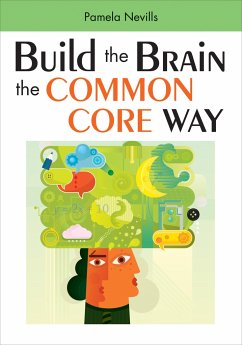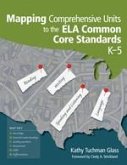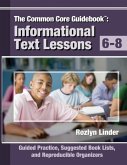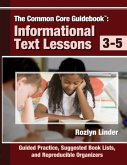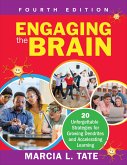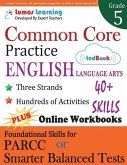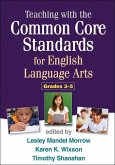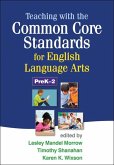Pamela A Nevills
Build the Brain the Common Core Way
Pamela A Nevills
Build the Brain the Common Core Way
- Broschiertes Buch
- Merkliste
- Auf die Merkliste
- Bewerten Bewerten
- Teilen
- Produkt teilen
- Produkterinnerung
- Produkterinnerung
This book is designed to help teachers take the mystique out of the CCSS and to be able to apply some immediate brain-compatible strategies in their classrooms. It provides some "soft answers" for school administrator to help teachers to be successful as they implement the changes that are required by the CCSS. The new standards are awash with terms that indicate that this initiative is more about deeper learning and thinking and how students can apply what they learn in school to their out-of-school experiences. Findings from neuroscience support this new direction and will be discussed throughout the book.…mehr
Andere Kunden interessierten sich auch für
![Mapping Comprehensive Units to the Ela Common Core Standards, K-5 Mapping Comprehensive Units to the Ela Common Core Standards, K-5]() Kathy Tuchman GlassMapping Comprehensive Units to the Ela Common Core Standards, K-545,99 €
Kathy Tuchman GlassMapping Comprehensive Units to the Ela Common Core Standards, K-545,99 €![The Common Core Guidebook, 6-8 The Common Core Guidebook, 6-8]() Rozlyn LinderThe Common Core Guidebook, 6-829,99 €
Rozlyn LinderThe Common Core Guidebook, 6-829,99 €![The Common Core Guidebook, 3-5 The Common Core Guidebook, 3-5]() Rozlyn LinderThe Common Core Guidebook, 3-531,99 €
Rozlyn LinderThe Common Core Guidebook, 3-531,99 €![Engaging the Brain Engaging the Brain]() Engaging the Brain37,99 €
Engaging the Brain37,99 €![Common Core Practice - 5th Grade English Language Arts: Workbooks to Prepare for the PARCC or Smarter Balanced Test Common Core Practice - 5th Grade English Language Arts: Workbooks to Prepare for the PARCC or Smarter Balanced Test]() Lumos LearningCommon Core Practice - 5th Grade English Language Arts: Workbooks to Prepare for the PARCC or Smarter Balanced Test17,99 €
Lumos LearningCommon Core Practice - 5th Grade English Language Arts: Workbooks to Prepare for the PARCC or Smarter Balanced Test17,99 €![Teaching with the Common Core Standards for English Language Arts, Grades 3-5 Teaching with the Common Core Standards for English Language Arts, Grades 3-5]() Teaching with the Common Core Standards for English Language Arts, Grades 3-541,99 €
Teaching with the Common Core Standards for English Language Arts, Grades 3-541,99 €![Teaching with the Common Core Standards for English Language Arts, PreK-2 Teaching with the Common Core Standards for English Language Arts, PreK-2]() Teaching with the Common Core Standards for English Language Arts, PreK-243,99 €
Teaching with the Common Core Standards for English Language Arts, PreK-243,99 €-
-
-
This book is designed to help teachers take the mystique out of the CCSS and to be able to apply some immediate brain-compatible strategies in their classrooms. It provides some "soft answers" for school administrator to help teachers to be successful as they implement the changes that are required by the CCSS. The new standards are awash with terms that indicate that this initiative is more about deeper learning and thinking and how students can apply what they learn in school to their out-of-school experiences. Findings from neuroscience support this new direction and will be discussed throughout the book.
Hinweis: Dieser Artikel kann nur an eine deutsche Lieferadresse ausgeliefert werden.
Hinweis: Dieser Artikel kann nur an eine deutsche Lieferadresse ausgeliefert werden.
Produktdetails
- Produktdetails
- Verlag: Sage Publications
- Seitenzahl: 144
- Erscheinungstermin: 15. April 2014
- Englisch
- Abmessung: 254mm x 182mm x 8mm
- Gewicht: 259g
- ISBN-13: 9781483352961
- ISBN-10: 148335296X
- Artikelnr.: 40032881
- Herstellerkennzeichnung
- Libri GmbH
- Europaallee 1
- 36244 Bad Hersfeld
- gpsr@libri.de
- Verlag: Sage Publications
- Seitenzahl: 144
- Erscheinungstermin: 15. April 2014
- Englisch
- Abmessung: 254mm x 182mm x 8mm
- Gewicht: 259g
- ISBN-13: 9781483352961
- ISBN-10: 148335296X
- Artikelnr.: 40032881
- Herstellerkennzeichnung
- Libri GmbH
- Europaallee 1
- 36244 Bad Hersfeld
- gpsr@libri.de
Pamela Nevills is first and foremost a teacher of children and adults. Her passion for teaching includes a full range of educator experiences from teaching in the primary grades, to teaching middle and high school, to being a teacher supervisor and instructor in university undergraduate, graduate, and doctoral programs. She participates in local, state, and national educational committees in the area of special education. As a two-time member of the instructional textbook selection committee for reading in the state of California, she brings expert knowledge of how children learn to read, and the materials teachers can use to follow the science of reading. Her passion for the cognitive and neurological aspects of reading stems from interactions with Dr. Pat Wolfe. Nevills is a national and international speaker and consultant on topics that include reading standards according to the Common Core; brain development from infancy to adulthood; all aspects of cognitive, neurological involvement for reading; and school management and design for teaching reading. Writing became a part of Nevills's work as she published for newsletters, the state of California, the Journal of Staff Development, and Corwin. Her involvement also includes research and studies for church organizations and an advisory board position for preschool. To contact Pamela Nevills, please email panevills@earthlink.net..
Preface
1. Teaching Can Be Like This
Different Expectations
Real School Examples
School Organization and Student Learning
Another Strong Example
A Brilliant Time to be in Education
2. Teaching that Looks Different
Common Core - What is so New?
Prepare Teachers
How Teachers Learn to Do What They Do
Learning to Learn
School Revolution Supported by Brain Science
Premium School Practices
The Traditional Lesson Plan
A New Lesson Plan Design
A Different Teacher Evaluation
Trying Something Different
It Matters How Students Feel about School
3. The Common Core Explained in Common Terms
Neuroscience Provides Answers
Some Basic Information
Know the Players
Look at Assessments
Common Core Assessment Designers
Other Organizations Have Their Say
Deeper Learning Defined
Next-Generation Assessments and Bloom¿s Taxonomy
The Common Core Standards in Common Language
Common Core for Literacy
Deeper Learning for ELA
What Literacy Standards do not Address
Common Core for Mathematics
Next Generation Science Standards
More Scientists, Engineers, and Mathematicians Needed
Questionable Reviews for NGSS
What is Still Needed?
4. How Learning Happens
Learning About Learning
Basic Brain Structures
The Site of Working Memory
The Sensory Input Systems
Filtering Systems
Neuroplasticity
Stimulating Classrooms
Memory Systems
Procedural Memory
Semantic Memory
Other Memory and Drill Practices
Deep Learning and Inner Connectivity
5. So Many Ways to Learn: What Teachers are Doing
A Bold Approach to Lesson Planning
Planning Questions
6. So Many Ways to Learn: What Students Do
Build in Brain Practices
Experience Concentrating
The Brain - A Pattern Seeking Organ
Rhyming, Rhythms, and Chants
Thinking Maps
Expanding Questions
Leading and Guiding Questions
Self Monitoring and Metacognition
A Study and Practice Episode
Thinking with the Brains CEO
Developing Critical Thinkers
Critical Thinking Skill Development through Metacognition
Use of Media Technology
One Last Useful Idea
7. Powerful Staff Development for Adult Learners
Staff Development, As Usual
Lost Impact from Training
Look to Teachers first
Research and Professional Development
Core Professional Development Practices
Staff Development, Responding to the Common Core
Teachers as Learners
Teachers as Leaders among their Peers
Teachers as Leaders for Student Learning
Close the Gap
8. Systems Change
Education Valued
Learning is Performance
Leadership and Student Learning
Soft, Definite Systems Change
What Districts are Doing
Focus on Student Learning
Include all Stakeholders
District Roadmap of Support
Social Relationships and Educational Change
Support Resources
Still to be Resolved
Problems and Answers
9. Explain the Learning Brain
References
1. Teaching Can Be Like This
Different Expectations
Real School Examples
School Organization and Student Learning
Another Strong Example
A Brilliant Time to be in Education
2. Teaching that Looks Different
Common Core - What is so New?
Prepare Teachers
How Teachers Learn to Do What They Do
Learning to Learn
School Revolution Supported by Brain Science
Premium School Practices
The Traditional Lesson Plan
A New Lesson Plan Design
A Different Teacher Evaluation
Trying Something Different
It Matters How Students Feel about School
3. The Common Core Explained in Common Terms
Neuroscience Provides Answers
Some Basic Information
Know the Players
Look at Assessments
Common Core Assessment Designers
Other Organizations Have Their Say
Deeper Learning Defined
Next-Generation Assessments and Bloom¿s Taxonomy
The Common Core Standards in Common Language
Common Core for Literacy
Deeper Learning for ELA
What Literacy Standards do not Address
Common Core for Mathematics
Next Generation Science Standards
More Scientists, Engineers, and Mathematicians Needed
Questionable Reviews for NGSS
What is Still Needed?
4. How Learning Happens
Learning About Learning
Basic Brain Structures
The Site of Working Memory
The Sensory Input Systems
Filtering Systems
Neuroplasticity
Stimulating Classrooms
Memory Systems
Procedural Memory
Semantic Memory
Other Memory and Drill Practices
Deep Learning and Inner Connectivity
5. So Many Ways to Learn: What Teachers are Doing
A Bold Approach to Lesson Planning
Planning Questions
6. So Many Ways to Learn: What Students Do
Build in Brain Practices
Experience Concentrating
The Brain - A Pattern Seeking Organ
Rhyming, Rhythms, and Chants
Thinking Maps
Expanding Questions
Leading and Guiding Questions
Self Monitoring and Metacognition
A Study and Practice Episode
Thinking with the Brains CEO
Developing Critical Thinkers
Critical Thinking Skill Development through Metacognition
Use of Media Technology
One Last Useful Idea
7. Powerful Staff Development for Adult Learners
Staff Development, As Usual
Lost Impact from Training
Look to Teachers first
Research and Professional Development
Core Professional Development Practices
Staff Development, Responding to the Common Core
Teachers as Learners
Teachers as Leaders among their Peers
Teachers as Leaders for Student Learning
Close the Gap
8. Systems Change
Education Valued
Learning is Performance
Leadership and Student Learning
Soft, Definite Systems Change
What Districts are Doing
Focus on Student Learning
Include all Stakeholders
District Roadmap of Support
Social Relationships and Educational Change
Support Resources
Still to be Resolved
Problems and Answers
9. Explain the Learning Brain
References
Preface
1. Teaching Can Be Like This
Different Expectations
Real School Examples
School Organization and Student Learning
Another Strong Example
A Brilliant Time to be in Education
2. Teaching that Looks Different
Common Core - What is so New?
Prepare Teachers
How Teachers Learn to Do What They Do
Learning to Learn
School Revolution Supported by Brain Science
Premium School Practices
The Traditional Lesson Plan
A New Lesson Plan Design
A Different Teacher Evaluation
Trying Something Different
It Matters How Students Feel about School
3. The Common Core Explained in Common Terms
Neuroscience Provides Answers
Some Basic Information
Know the Players
Look at Assessments
Common Core Assessment Designers
Other Organizations Have Their Say
Deeper Learning Defined
Next-Generation Assessments and Bloom¿s Taxonomy
The Common Core Standards in Common Language
Common Core for Literacy
Deeper Learning for ELA
What Literacy Standards do not Address
Common Core for Mathematics
Next Generation Science Standards
More Scientists, Engineers, and Mathematicians Needed
Questionable Reviews for NGSS
What is Still Needed?
4. How Learning Happens
Learning About Learning
Basic Brain Structures
The Site of Working Memory
The Sensory Input Systems
Filtering Systems
Neuroplasticity
Stimulating Classrooms
Memory Systems
Procedural Memory
Semantic Memory
Other Memory and Drill Practices
Deep Learning and Inner Connectivity
5. So Many Ways to Learn: What Teachers are Doing
A Bold Approach to Lesson Planning
Planning Questions
6. So Many Ways to Learn: What Students Do
Build in Brain Practices
Experience Concentrating
The Brain - A Pattern Seeking Organ
Rhyming, Rhythms, and Chants
Thinking Maps
Expanding Questions
Leading and Guiding Questions
Self Monitoring and Metacognition
A Study and Practice Episode
Thinking with the Brains CEO
Developing Critical Thinkers
Critical Thinking Skill Development through Metacognition
Use of Media Technology
One Last Useful Idea
7. Powerful Staff Development for Adult Learners
Staff Development, As Usual
Lost Impact from Training
Look to Teachers first
Research and Professional Development
Core Professional Development Practices
Staff Development, Responding to the Common Core
Teachers as Learners
Teachers as Leaders among their Peers
Teachers as Leaders for Student Learning
Close the Gap
8. Systems Change
Education Valued
Learning is Performance
Leadership and Student Learning
Soft, Definite Systems Change
What Districts are Doing
Focus on Student Learning
Include all Stakeholders
District Roadmap of Support
Social Relationships and Educational Change
Support Resources
Still to be Resolved
Problems and Answers
9. Explain the Learning Brain
References
1. Teaching Can Be Like This
Different Expectations
Real School Examples
School Organization and Student Learning
Another Strong Example
A Brilliant Time to be in Education
2. Teaching that Looks Different
Common Core - What is so New?
Prepare Teachers
How Teachers Learn to Do What They Do
Learning to Learn
School Revolution Supported by Brain Science
Premium School Practices
The Traditional Lesson Plan
A New Lesson Plan Design
A Different Teacher Evaluation
Trying Something Different
It Matters How Students Feel about School
3. The Common Core Explained in Common Terms
Neuroscience Provides Answers
Some Basic Information
Know the Players
Look at Assessments
Common Core Assessment Designers
Other Organizations Have Their Say
Deeper Learning Defined
Next-Generation Assessments and Bloom¿s Taxonomy
The Common Core Standards in Common Language
Common Core for Literacy
Deeper Learning for ELA
What Literacy Standards do not Address
Common Core for Mathematics
Next Generation Science Standards
More Scientists, Engineers, and Mathematicians Needed
Questionable Reviews for NGSS
What is Still Needed?
4. How Learning Happens
Learning About Learning
Basic Brain Structures
The Site of Working Memory
The Sensory Input Systems
Filtering Systems
Neuroplasticity
Stimulating Classrooms
Memory Systems
Procedural Memory
Semantic Memory
Other Memory and Drill Practices
Deep Learning and Inner Connectivity
5. So Many Ways to Learn: What Teachers are Doing
A Bold Approach to Lesson Planning
Planning Questions
6. So Many Ways to Learn: What Students Do
Build in Brain Practices
Experience Concentrating
The Brain - A Pattern Seeking Organ
Rhyming, Rhythms, and Chants
Thinking Maps
Expanding Questions
Leading and Guiding Questions
Self Monitoring and Metacognition
A Study and Practice Episode
Thinking with the Brains CEO
Developing Critical Thinkers
Critical Thinking Skill Development through Metacognition
Use of Media Technology
One Last Useful Idea
7. Powerful Staff Development for Adult Learners
Staff Development, As Usual
Lost Impact from Training
Look to Teachers first
Research and Professional Development
Core Professional Development Practices
Staff Development, Responding to the Common Core
Teachers as Learners
Teachers as Leaders among their Peers
Teachers as Leaders for Student Learning
Close the Gap
8. Systems Change
Education Valued
Learning is Performance
Leadership and Student Learning
Soft, Definite Systems Change
What Districts are Doing
Focus on Student Learning
Include all Stakeholders
District Roadmap of Support
Social Relationships and Educational Change
Support Resources
Still to be Resolved
Problems and Answers
9. Explain the Learning Brain
References

